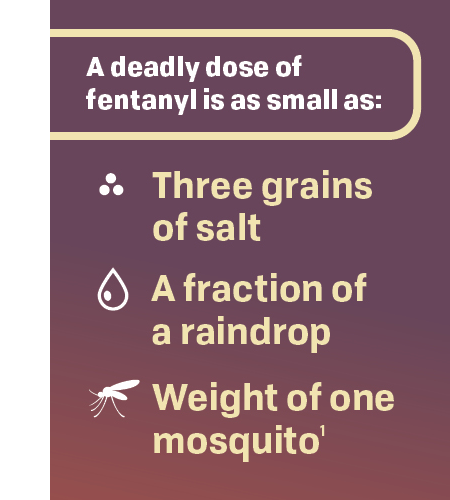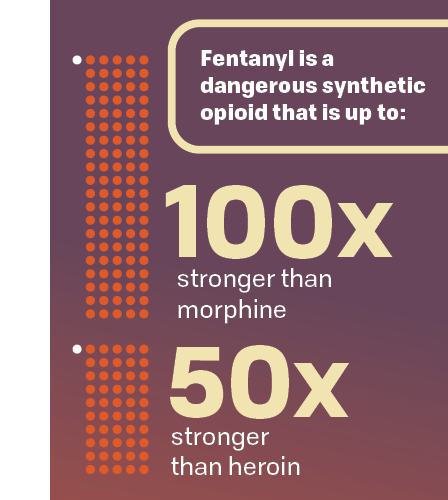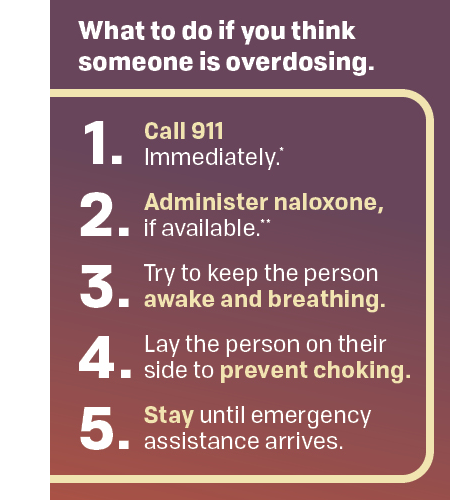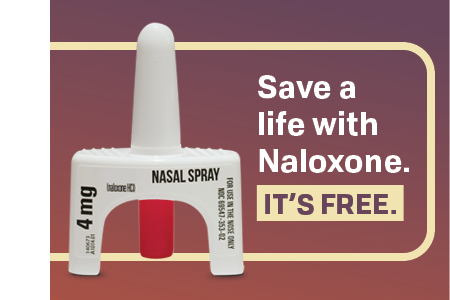What to know about fentanyl and overdoses
 Fentanyl is one of the most common drugs found in overdose deaths. That's partly because fentanyl can be deadly even in small doses. People using drugs may not know they are taking it. Opioids, including fentanyl, claim more than 150 lives every day.1
Fentanyl is one of the most common drugs found in overdose deaths. That's partly because fentanyl can be deadly even in small doses. People using drugs may not know they are taking it. Opioids, including fentanyl, claim more than 150 lives every day.1
Fentanyl overdoses and fentanyl-involved deaths can happen when another drugs contains fentanyl. Fentanyl has no taste, color or smell, so it isn't easy to detect if mixed in with other drugs.
When you take a drug laced with fentanyl — even by mistake — you risk losing everything you love in an instant. That's why it's so important to learn how to stay safe from fentanyl.
What is fentanyl?
Fentanyl is a synthetic opioid. There are two types of fentanyl:
- Pharmaceutical fentanyl, prescribed by doctors to treat advanced-stage cancers and severe surgery pain
- Illegally made fentanyl (IMF), used in the illegal drug market
Both types of fentanyl are powerful synthetic opioids that are up to:
- 50x stronger than heroin
- 100x stronger than morphine1
Deaths from illegal fentanyl are on the rise.
The rise in overdoses is a result of cheaper fentanyl knockoffs that have strong effects. Fentanyl mixed with other drugs makes them stronger, cheaper and more addictive.
- More than 56,000 American died from overdoses involving synthetic opioids in 2020.
- Overdose deaths from synthetic opioids, like fentanyl and fentanyl knockoffs, grew 56% from 2019 to 2020 in the U.S.
- Nationwide, the number of overdose deaths involving synthetic opioids in 2020 was more than 18 times the number in 2013.2
Learn the signs of a fentanyl overdose.
By knowing the signs of opioid overdose, you can help save a life. Here are some things to look for in a person you think may be overdosing:
- Small pupils
- Falling asleep or passing out
- Slow, weak, or no breathing
- Choking or gurgling sounds
- Limp body
- Cold and/or clammy skin
- Blue or purple skin (especially in lips and nails)
What to do if you think someone is overdosing.
It may be hard to tell whether a person is high or having an overdose. If you aren't sure, treat it like an overdose — you can save a life.
- Call 911 immediately.*
- Administer naloxone, if available.
- Try to keep the person awake and breathing.
- Lay the person on their side to prevent choking.
- Stay with the person until emergency help arrives.
Note: Iowa's Good Samaritan laws protect a witness reporting an overdose from legal trouble in most cases.
Free naloxone can help you reverse an overdose.
Naloxone is an FDA-approved drug that works fast to reverse an opioid overdose. It restores breathing a short time after administration. Naloxone is available as a nasal spray (sometimes called NARCAN). NARCAN is an injectable form or in an auto-injectable form and is easy and safe to use. Naloxone is safe, even if someone doesn't have opioids in their system.
opioid overdose. It restores breathing a short time after administration. Naloxone is available as a nasal spray (sometimes called NARCAN). NARCAN is an injectable form or in an auto-injectable form and is easy and safe to use. Naloxone is safe, even if someone doesn't have opioids in their system.
You can save a life by having naloxone on hand. Naloxone may be available for free at your local pharmacy or other participating organizations. You can also get it with a prescription or purchase it over the counter. Visit naloxoneiowa.org to learn more.
Learn more about fentanyl with these resources.
- CDC Podcast – The Dangers of Fentanyl
- Synthetic Opioid Overdose Data
- Illicit Opioid Graphics
- CDC’s Overdose Prevention
- Know the Signs and Get Help for Opioid Addiction
Citations
1 Centers for Disease Control and Prevention. “Fentanyl Facts.” June 27, 2023. Accessed from CDC - Fentanyl Facts.
2 Centers for Disease Control and Prevention. “Synthetic Opioid Overdose Data.” June 6, 2022. Accessed from CDC - Synthetic Opioid Overdose Data.

